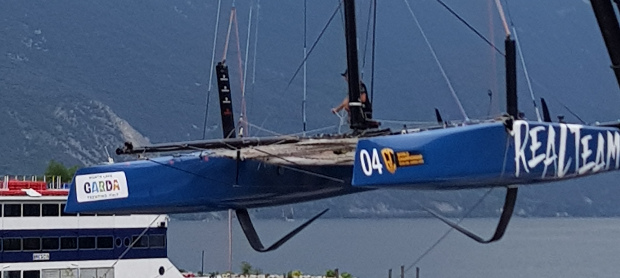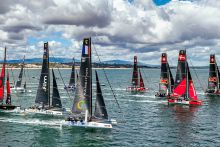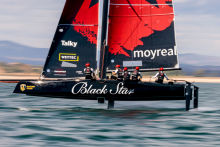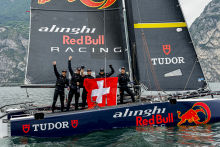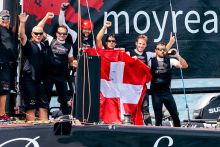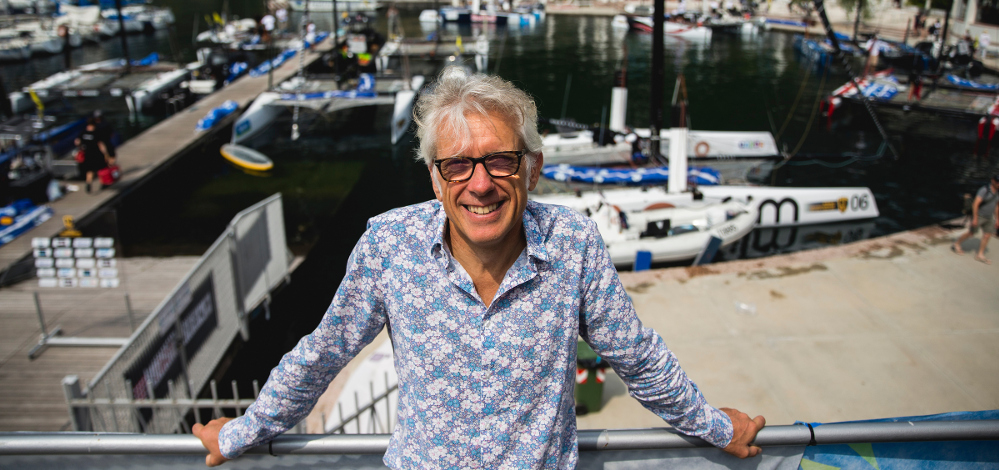
From Cup to GC32 and back
By on 15 Jun. 2018
While credit for the GC32 catamaran’s original concept belongs to Laurent Lenne, who markets the boat via his Netherlands-based company Great Cup BV, and Andrew Macpherson, design work on what is today the world’s most successful one design foiling race boat, was carried out by Dr Martin Fischer.
Originally from Germany but since 2000 a resident of New Caledonia, Fischer is unquestionably one of the larger-brained of the human race with a degree in physics (focus on fluid dynamics; his thesis on wing section optimisation) and a PhD in geophysics (focus on climate predictions).
A well-known designer of A-Class and F18 dinghy catamarans, classes in which he personally sailed, Fischer’s leg up into yacht design came from Franck Cammas, working on his trimaran projects and on the foils for his Volvo Ocean Race-winning Groupama 4 VO70. He continued in the development team for Cammas’ all-conquering C-Class flying catamaran Groupama C and subsequently for Team France’s foiling AC50 in Bermuda last year.
Amid this Fischer first penned the GC32. Then after foiling catamarans debuted in the America’s Cup in 2012, he followed with Mk2 appendages for the GC32 – J-shaped foils and inverted-T rudders – that made it fly.
Today Fischer holds one of yacht design’s highest positions, as Design Co-Ordinator for Luna Rossa, Challenger of Record for the 36th America’s Cup. In this role he has been heavily involved in conceiving the new generation AC75 foiling monohulls.
Fischer was in Riva del Garda last month for the first GC32 World Championship, as one of the flying catamarans’ founding fathers, present along with Laurent Lenne: “It is nice to see 13 boats in the harbour and out on the water. It has become quite successful with the two circuits running in parallel. It is nice they are racing together now. In the beginning we had hoped for this…”
Many of the reasons for the GC32’s success lies in its original concept: “It was always designed as a foiling boat which is why it has relatively huge beams,” Fischer explains. “Right from the beginning they wanted a really stiff platform. That proved to be a very good decision.” For foils to work accurately, rigidity across the platform is vital, minimising flex and twist within and between the hulls.
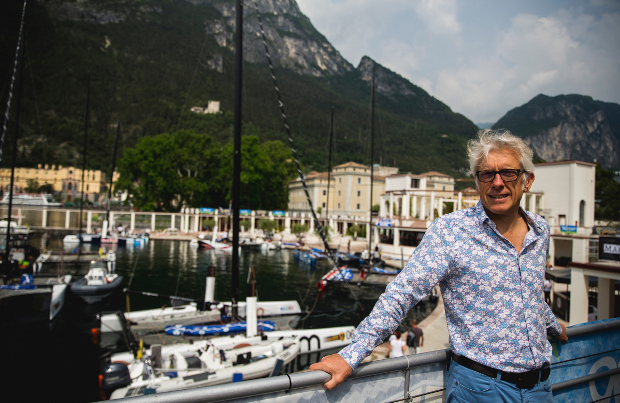
Becoming a full foiler transformed the GC32’s performance. Recorded 40+ knot peak speeds may be down to GPS aberrations, but the boat has come close and for those graduating up from monohulls, it remains insanely fast. At the recent World Championship GC32s were regularly hitting 34-35 knots in just 18 knots of wind.
Last year on the AC50s, control of wing and foils was almost 100% hydraulic, powered by an army of grinders/cyclists and these might have been engine-driven and automatically controlled by computer, leaving humans all but redundant had rules not prevented this. While this is one future for cutting edge sailing, another is the GC32, which embraces catamaran foiling while maintaining human control.
“I still very much like the concept of the GC32, which you can sail without automatic systems and no hydraulics,” says Fischer. This, along with the softsail rig and its familiar sail controls, is what helps crews transition easily into it from ‘conventional boats’. In fact this was one of the principle considerations of the GC32’s design and one reason why the GC32’s foils are fine for most crews, even if they are perhaps not today’s state of the art.
The new AC75 monohull is fitted with twin T-foils and Fischer believes that this could be a solution if in the future there is the desire to upgrade the GC32’s foil package. “The boat would be quicker, but with T-foils the righting moment goes up and I’m not sure that the rest of the boat could withstand the higher loads which would go up by 30% or so.”
Another alternative to improve performance would be to replace the existing foil package with more refined versions of the present configuration. This could involve going ‘higher aspect’ (ie longer and narrower) with both sets of foils and increasing the area of them.
“That would make manoeuvres easier – foiling and gybing especially, because right now you have to go into a gybe at high speed to make sure it doesn’t go nose-up. With a bigger elevator [the lifting surfaces on the rudders] that would be easier and it would also allow upwind foiling.”
At present the GC32s cannot quite foil upwind like AC50s or the AC72s, because the area of the foils providing vertical lift simply isn’t large enough (although on some legs at the GC32 World Championship, the boats were flying upwind, albeit slightly cracked as they returned from ‘the cliff’).
Foiling upwind would represent a great performance hike, but replacing the foils is just one change required to achieve this, Fischer explains. “Foiling upwind is very difficult even if you have foils that are made for it, because the energy you need to trim the mainsail goes up very dramatically.” To resolve this hydraulics may be required.
“So it might be best to just keep it as it is,” says Fischer. “The foils are okay for owner-drivers. Upwind the boat doesn’t really foil which ensures that it doesn’t need to be too complicated. The present foil configuration is more or less inherently stable. You can use the foil’s rake adjustment for take-off and then you can adjust it and that seems to be sufficient, although if you want to win you have to trim it more. If you installed a complex hydraulic system then the maintenance and costs would go to another level.”
A third replacement foil option would be to enlarge the present stable J-shaped main lifting foils, although this would still require an increased rudder elevator size. This would trade lower lift-off speed for ultimate top speed, but as Fischer notes “none of the crews are complaining the top speed is too low. Most of the teams have said that they’d prefer this if light wind performance was better.” At present the GC32 takes off in 7 knots wind/15-16 knots boat speed. Fischer reckons with bigger foils this could come down to 13-14 knots boat speed, but warns: “But then it would fly upwind…”
While the ‘hydro package’ might be best left alone unless owners are ready to invest heavily, cheaper improvements could be made to the ‘aero package’ which would be more subtle yet still effective. This doesn’t mean fitting a wing with its high efficiency, but inherent impracticality. Instead Fischer says the big ticket items would an air-tight trampoline and ‘deck-sweeper’ sails, using the trampoline or a solid deck to create an end plate for the foot of the sails. So how much of an improvement might all that make? “I guess upwind it could be 1+ knot,” says Fischer.
At present the GC32 uses netting between the hulls, however Cup teams found benefit in using solid fabric trampolines (ie without holes), which also would deflect/stretch less. The foot of the ‘deck-sweeper’ mainsails can then extend down to this flatter trampoline, with the boom replaced by a windsurfer-style wishbone arrangement and a cut-out around the mainsail clew, ahead of the main sheet, to allow crew across the boat in manoeuvres. Fischer says these trampolines can also form fairings for the cross beams. “That is more aesthetic, but the jib end plate and the deck sweeper mainsail make a huge difference and could be easily fitted to the existing boats at not much cost.”
However he concludes: “At the moment it works fine. To me, the GC32 class the class looks healthy, so therefore perhaps you shouldn’t change too much.”
